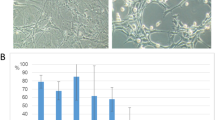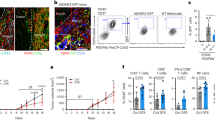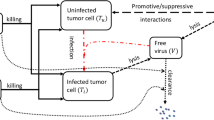Abstract
Mesenchymal stromal cells (MSC) can be exploited as cellular delivery vehicles for the enzymes converting non-toxic prodrugs to toxic substances. Because of their inherent chemoresistance, they exert potent bystander and antitumor effect. Here we show that the human adipose tissue-derived MSC expressing fusion yeast cytosine deaminase::uracil phosphoribosyltransferase (CD-MSC) in combination with 5-fluorocytosine (5FC) mediated a long-term tumor-free survival in the 83.3% of tumor-bearing animals. CD-MSC/5FC treatment induced cytotoxicity against model human melanoma cells EGFP-A375. Only 4% of the therapeutic CD-MSC cells eliminated >98.5% of the tumor cells in vitro. Long-term tumor-free survival was confirmed in 15 out of the 18 animals. However, repeatedly used CD-MSC/5FC therapeutic regimen generated more aggressive and metastatic variant of the melanoma cells EGFP-A375/Rel3. These cells derived from the refractory xenotransplants exhibited increased resistance to the CD-MSC/5FC treatment, altered cell adhesion, migration, tumorigenic and metastatic properties. However, long-term curative effect was achieved by the augmentation of the CD-MSC/5FC regimen along with the inhibition of c-Met/hepatocyte growth factor signaling axis in this aggressive melanoma derivative. In summary, the CD-MSC/5FC regimen can be regarded as a very effective antitumor approach to achieve long-term tumor-free survival as demonstrated on a mouse model of aggressive human melanoma xenografts.
This is a preview of subscription content, access via your institution
Access options
Subscribe to this journal
Receive 12 print issues and online access
$259.00 per year
only $21.58 per issue
Buy this article
- Purchase on Springer Link
- Instant access to full article PDF
Prices may be subject to local taxes which are calculated during checkout






Similar content being viewed by others
References
Portsmouth D, Hlavaty J, Renner M . Suicide genes for cancer therapy. Mol Aspects Med 2007; 28: 4–41.
Camassola M, de Macedo Braga LM, Chagastelles PC, Nardi NB . Methodology, biology and clinical applications of human mesenchymal stem cells. Methods Mol Biol 2012; 879: 491–504.
Myers TJ, Granero-Molto F, Longobardi L, Li T, Yan Y, Spagnoli A . Mesenchymal stem cells at the intersection of cell and gene therapy. Expert Opin Biol Ther 2010; 10: 1663–1679.
Durinikova E, Kucerova L, Matuskova M . Mesenchymal stromal cells retrovirally transduced with prodrug-converting genes are suitable vehicles for cancer gene therapy. Acta Virol 2014; 58: 1–13.
Schaffler A, Buchler C . Concise review: adipose tissue-derived stromal cells–basic and clinical implications for novel cell-based therapies. Stem Cells 2007; 25: 818–827.
Serakinci N, Christensen R, Fahrioglu U, Sorensen FB, Dagnaes-Hansen F, Hajek M et al. Mesenchymal stem cells as therapeutic delivery vehicles targeting tumor stroma. Cancer Biother Radiopharm 2011; 26: 767–773.
Cihova M, Altanerova V, Altaner C . Stem cell based cancer gene therapy. Mol Pharm 2011; 8: 1480–1487.
Kucerova L, Poturnajova M, Tyciakova S, Matuskova M . Increased proliferation and chemosensitivity of human mesenchymal stromal cells expressing fusion yeast cytosine deaminase. Stem Cell Res 2012; 8: 247–258.
Li J, Law HK, Lau YL, Chan GC . Differential damage and recovery of human mesenchymal stem cells after exposure to chemotherapeutic agents. Br J Haematol 2004; 127: 326–334.
Liang W, Xia H, Li J, Zhao RC . Human adipose tissue derived mesenchymal stem cells are resistant to several chemotherapeutic agents. Cytotechnology 2011; 63: 523–530.
Uchibori R, Okada T, Ito T, Urabe M, Mizukami H, Kume A et al. Retroviral vector-producing mesenchymal stem cells for targeted suicide cancer gene therapy. J Gene Med 2009; 11: 373–381.
Matuskova M, Hlubinova K, Pastorakova A, Hunakova L, Altanerova V, Altaner C et al. HSV-tk expressing mesenchymal stem cells exert bystander effect on human glioblastoma cells. Cancer Lett 2010; 290: 58–67.
Ryu CH, Park KY, Kim SM, Jeong CH, Woo JS, Hou Y et al. Valproic acid enhances anti-tumor effect of mesenchymal stem cell mediated HSV-TK gene therapy in intracranial glioma. Biochem Biophys Res Commun 2012; 421: 585–590.
Kim SW, Kim SJ, Park SH, Yang HG, Kang MC, Choi YW et al. Complete regression of metastatic renal cell carcinoma by multiple injections of engineered mesenchymal stem cells expressing dodecameric TRAIL and HSV-TK. Clin Cancer Res 2013; 19: 415–427.
Gutova M, Shackleford GM, Khankaldyyan V, Herrmann KA, Shi XH, Mittelholtz K et al. Neural stem cell-mediated CE/CPT-11 enzyme/prodrug therapy in transgenic mouse model of intracerebellar medulloblastoma. Gene Therapy 2013; 20: 143–150.
Gutova M, Najbauer J, Chen MY, Potter PM, Kim SU, Aboody KS . Therapeutic targeting of melanoma cells using neural stem cells expressing carboxylesterase, a CPT-11 activating enzyme. Curr Stem Cell Res Ther 2010; 5: 273–276.
Danks MK, Yoon KJ, Bush RA, Remack JS, Wierdl M, Tsurkan L et al. Tumor-targeted enzyme/prodrug therapy mediates long-term disease-free survival of mice bearing disseminated neuroblastoma. Cancer Res 2007; 67: 22–25.
Matuskova M, Baranovicova L, Kozovska Z, Durinikova E, Pastorakova A, Hunakova L et al. Intrinsic properties of tumour cells have a key impact on the bystander effect mediated by genetically engineered mesenchymal stromal cells. J Gene Med 2012; 14: 776–787.
Longley DB, Harkin DP, Johnston PG . 5-fluorouracil: mechanisms of action and clinical strategies. Nat Rev Cancer 2003; 3: 330–338.
Kucerova L, Altanerova V, Matuskova M, Tyciakova S, Altaner C . Adipose tissue-derived human mesenchymal stem cells mediated prodrug cancer gene therapy. Cancer Res 2007; 67: 6304–6313.
Cavarretta IT, Altanerova V, Matuskova M, Kucerova L, Culig Z, Altaner C . Adipose tissue-derived mesenchymal stem cells expressing prodrug-converting enzyme inhibit human prostate tumor growth. Mol Ther 2010; 18: 223–231.
Kucerova L, Matuskova M, Pastorakova A, Tyciakova S, Jakubikova J, Bohovic R et al. Cytosine deaminase expressing human mesenchymal stem cells mediated tumour regression in melanoma bearing mice. J Gene Med 2008; 10: 1071–1082.
Altanerova V, Cihova M, Babic M, Rychly B, Ondicova K, Mravec B et al. Human adipose tissue-derived mesenchymal stem cells expressing yeast cytosinedeaminase::uracil phosphoribosyltransferase inhibit intracerebral rat glioblastoma. Int J Cancer 2012; 130: 2455–2463.
Kenessey I, Keszthelyi M, Kramer Z, Berta J, Adam A, Dobos J et al. Inhibition of c-Met with the specific small molecule tyrosine kinase inhibitor SU11274 decreases growth and metastasis formation of experimental human melanoma. Curr Cancer Drug Targets 2010; 10: 332–342.
van Leenders GJ, Sookhlall R, Teubel WJ, de Ridder CM, Reneman S, Sacchetti A et al. Activation of c-MET induces a stem-like phenotype in human prostate cancer. PLoS One 2011; 6: e26753.
Nishida S, Hirohashi Y, Torigoe T, Inoue R, Kitamura H, Tanaka T et al. Prostate cancer stem-like cells/cancer-initiating cells have an autocrine system of hepatocyte growth factor. Cancer Sci 2013; 104: 431–436.
Li Y, Li A, Glas M, Lal B, Ying M, Sang Y et al. c-Met signaling induces a reprogramming network and supports the glioblastoma stem-like phenotype. Proc Natl Acad Sci USA 2011; 108: 9951–9956.
Xu L, Shen SS, Hoshida Y, Subramanian A, Ross K, Brunet JP et al. Gene expression changes in an animal melanoma model correlate with aggressiveness of human melanoma metastases. Mol Cancer Res 2008; 6: 760–769.
Kucerova L, Matuskova M, Hlubinova K, Altanerova V, Altaner C . Tumor cell behaviour modulation by mesenchymal stromal cells. Mol Cancer 2010; 9: 129.
Amano S, Gu C, Koizumi S, Tokuyama T, Namba H . Timing of ganciclovir administration in glioma gene therapy using HSVtk gene-transduced mesenchymal stem cells. Cancer Genomics Proteomics 2011; 8: 245–250.
de Souza AP, Bonorino C . The immune system: endogenous anticancer mechanism. Front Biosci (Elite Ed) 2012; 4: 2354–2364.
Paez D, Labonte MJ, Bohanes P, Zhang W, Benhanim L, Ning Y et al. Cancer dormancy: a model of early dissemination and late cancer recurrence. Clin Cancer Res 2012; 18: 645–653.
De Craene B, Berx G . Regulatory networks defining EMT during cancer initiation and progression. Nat Rev Cancer 2013; 13: 97–110.
Kim JE, Leung E, Baguley BC, Finlay GJ . Heterogeneity of expression of epithelial-mesenchymal transition markers in melanocytes and melanoma cell lines. Front Genet 2013; 4: 97.
Shirley SH, Greene VR, Duncan LM, Torres Cabala CA, Grimm EA, Kusewitt DF . Slug expression during melanoma progression. Am J Pathol 2012; 180: 2479–2489.
Rouleau C, Smale R, Sancho J, Fu YS, Kurtzberg L, Weber W et al. Endosialin: a novel malignant cell therapeutic target for neuroblastoma. Int J Oncol 2011; 39: 841–851.
Brabletz T . EMT and MET in metastasis: where are the cancer stem cells? Cancer Cell 2012; 22: 699–701.
Singh A, Settleman J . EMT, cancer stem cells and drug resistance: an emerging axis of evil in the war on cancer. Oncogene 2010; 29: 4741–4751.
La Porta C . Cancer stem cells: lessons from melanoma. Stem Cell Rev 2009; 5: 61–65.
Rocco M, Malorni L, Cozzolino R, Palmieri G, Rozzo C, Manca A et al. Proteomic profiling of human melanoma metastatic cell line secretomes. J Proteome Res 2011; 10: 4703–4714.
Mauerer A, Roesch A, Hafner C, Stempfl T, Wild P, Meyer S et al. Identification of new genes associated with melanoma. Exp Dermatol 2011; 20: 502–507.
Fukunaga-Kalabis M, Martinez G, Nguyen TK, Kim D, Santiago-Walker A, Roesch A et al. Tenascin-C promotes melanoma progression by maintaining the ABCB5-positive side population. Oncogene 2010; 29: 6115–6124.
Pierard GE, Pierard-Franchimont C, Delvenne P . Malignant melanoma and its stromal nonimmune microecosystem. J Oncol 2012; 2012: 584219.
Westhoff MA, Fulda S . Adhesion-mediated apoptosis resistance in cancer. Drug Resist Updat 2009; 12: 127–136.
Westhoff MA, Bruhl O, Nonnenmacher L, Karpel-Massler G, Debatin KM . Killing me softly–future challenges in apoptosis research. Int J Mol Sci 2014; 15: 3746–3767.
Kucerova L, Skolekova S . Tumor microenvironment and the role of mesenchymal stromal cells. Neoplasma 2013; 60: 1–10.
Hofmann UB, Houben R, Brocker EB, Becker JC . Role of matrix metalloproteinases in melanoma cell invasion. Biochimie 2005; 87: 307–314.
Toricelli M, Melo FH, Peres GB, Silva DC, Jasiulionis MG . Timp1 interacts with beta-1 integrin and CD63 along melanoma genesis and confers anoikis resistance by activating PI3-K signaling pathway independently of Akt phosphorylation. Mol Cancer 2013; 12: 22.
Defamie N, Chepied A, Mesnil M . Connexins, gap junctions and tissue invasion. FEBS Lett 2014; 588: 1331–1338.
Kurtenbach S, Zoidl G . Gap junction modulation and its implications for heart function. Front Physiol 2014; 5: 82.
Metildi CA, Kaushal S, Hoffman RM, Bouvet M . In vivo serial selection of human pancreatic cancer cells in orthotopic mouse models produces high metastatic variants irrespective of Kras status. J Surg Res 2013; 184: 290–298.
Adamcic U, Skowronski K, Peters C, Morrison J, Coomber BL . The effect of bevacizumab on human malignant melanoma cells with functional VEGF/VEGFR2 autocrine and intracrine signaling loops. Neoplasia 2012; 14: 612–623.
Piao Y, Liang J, Holmes L, Zurita AJ, Henry V, Heymach JV et al. Glioblastoma resistance to anti-VEGF therapy is associated with myeloid cell infiltration, stem cell accumulation, and a mesenchymal phenotype. Neuro Oncol 2012; 14: 1379–1392.
Lee TH, Seng S, Sekine M, Hinton C, Fu Y, Avraham HK et al. Vascular endothelial growth factor mediates intracrine survival in human breast carcinoma cells through internally expressed VEGFR1/FLT1. PLoS Med 2007; 4: e186.
Shakhova O, Sommer L . Testing the cancer stem cell hypothesis in melanoma: the clinics will tell. Cancer Lett 2013; 338: 74–81.
Das Thakur M, Stuart DD . The evolution of melanoma resistance reveals therapeutic opportunities. Cancer Res 2013; 73: 6106–6110.
Meacham CE, Morrison SJ . Tumour heterogeneity and cancer cell plasticity. Nature 2013; 501: 328–337.
De Sousa EMF, Vermeulen L, Fessler E, Medema JP . Cancer heterogeneity–a multifaceted view. EMBO Rep 2013; 14: 686–695.
Kucerova L, Skolekova S, Matuskova M, Bohac M, Kozovska Z . Altered features and increased chemosensitivity of human breast cancer cells mediated by adipose tissue-derived mesenchymal stromal cells. BMC Cancer 2013; 13: 535.
Kucerova L, Kovacovicova M, Polak S, Bohac M, Fedeles J, Palencar D et al. Interaction of human adipose tissue-derived mesenchymal stromal cells with breast cancer cells. Neoplasma 2011; 58: 361–370.
Acknowledgements
We thank M Dubrovcakova and V Frivalska for the excellent technical assistance. We acknowledge M Cihova for the help with manuscript editing and language corrections. The support and help with the data interpretation from M Mego, MD, PhD is highly appreciated. This work was supported by the Slovak Research and Development Agency under the contract No. APVV-0230-11 (to LK) and APVV-0052-12 (to MM), Scientific Grant Agency VEGA grant No. 2/0088/11 (to LK) and 2/0171/13 (to MM). The expression analysis, fluorimetric measurements and live-cell kinetic imaging was co-financed by the Cancer Research Foundation funds WAC2003, RFL2009 and RFL2012.
AUTHOR CONTRIBUTIONS
Conception, design and development of methodology: LK; data acquisition: LK, SS, LD, RB and MM; analysis and data interpretation: LK and MM; writing of the manuscript and review: LK.
Author information
Authors and Affiliations
Corresponding author
Ethics declarations
Competing interests
The authors declare no conflict of interest.
Additional information
Supplementary Information accompanies this paper on Gene Therapy website
Supplementary information
Rights and permissions
About this article
Cite this article
Kucerova, L., Skolekova, S., Demkova, L. et al. Long-term efficiency of mesenchymal stromal cell-mediated CD-MSC/5FC therapy in human melanoma xenograft model. Gene Ther 21, 874–887 (2014). https://doi.org/10.1038/gt.2014.66
Received:
Revised:
Accepted:
Published:
Issue Date:
DOI: https://doi.org/10.1038/gt.2014.66
This article is cited by
-
Mitochondrial oxidative phosphorylation in cutaneous melanoma
British Journal of Cancer (2021)
-
ALDH1A3 upregulation and spontaneous metastasis formation is associated with acquired chemoresistance in colorectal cancer cells
BMC Cancer (2018)
-
Role of the HGF/c-MET tyrosine kinase inhibitors in metastasic melanoma
Molecular Cancer (2018)
-
Cytotoxic response of 5-fluorouracil-resistant cells to gene- and cell-directed enzyme/prodrug treatment
Cancer Gene Therapy (2018)
-
iPS-derived MSCs from an expandable bank to deliver a prodrug-converting enzyme that limits growth and metastases of human breast cancers
Cell Death Discovery (2017)



